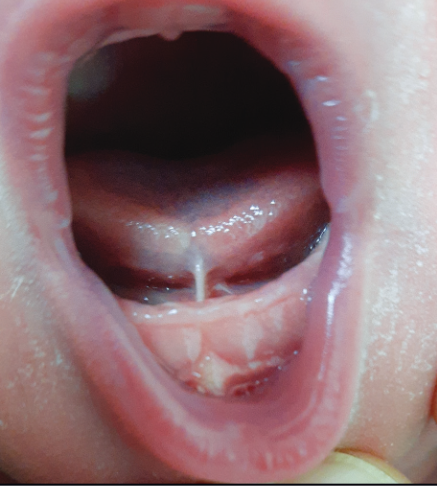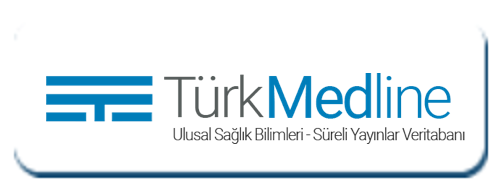Efficacy of tongue-tie excision in the treatment of childhood ankyloglossia: 8 years of experience in a single-center
DOI:
https://doi.org/10.5281/zenodo.7568801Keywords:
Ankyloglossia, Breastfeeding, Childhood, FrenotomyAbstract
Objective: This study aims to present the results of the frenotomy technique in conditions of ankyloglossia (tongue-tie) identified and cured in the first ten years of life.
Materials and methods: In this study, ankyloglossia cases operated on between April 2014 and March 2022 in the Karaman Training and Research Hospital Pediatric Surgery Clinic were retrospectively reviewed. The number of patients included in the study age group was as follows; 0-90 days 180 (63.3%), 90-360 days, 76 (26.8%), 360 days-10 years 28 (9.9%).
Results: Frenotomy was carried out on 284 patients, 228 (80.3%) boys and 56 girls (19.7%) with tongue-tie between the ages of one day-10 years. The number of them included in the study age groups was as follows; 0-90 days, 180 (63.3%), 90-360 days, 76 (26.8%), 360 days-10 years 28 (9.9%). The patients were classified as 173 patients with type 1, 94 patients with type 2, 6 patients with type 3, and 11 patients with type 4 according to the Coryllos classification defined according to the examination findings. During frenotomy, no anesthesia was performed on the patients in Group 1, general anesthesia was administered to 10 of 48 patients in Group 2, and 11 of 14 patients in Group 3. At follow-up, all patients showed significant improvement in sucking and the baby’s nipple grip. Considering all patients, 54 (75%)of 72 mothers with nipple pain improved.
Conclusions: Frenotomy is a surgical procedure that may require general anesthesia and has few complications, especially in babies older than 3 months.
References
Ngerncham S, Laohapensang M, Wongvisutdhi T, Ritjaroen Y, Painpichan N, Hakularb P, et al. Lingual frenulum, and effect on breastfeeding in Thai newborn infants. Paediatr Int Child Health. 2013;33(2):86-90.
Bai PM, Vaz AC. Ankyloglossia among children of regular and special schools in Karnataka, India: a prevalence study. J Clin Diagn Res. 2014;8(6):36-8.
González Jiménez D, Costa Romero M, Riaño Galán I, González Martínez MT, Rodríguez Pando MC, Lobete Prieto C. Prevalance of ankyloglossia in newborns in Asturias (Spain). An Pediatr (Barc). 2014;81(2):115-9.
Sethi N, Smith D, Kortequee S, Ward VM, Clarke S. Benefits of frenotomy in infants with ankyloglossia. Int J Pediatr Otorhinolaryngol. 2013;77(5):762-5.
Dollberg S, Marom R, Botzer E. Lingual frenotomy for breastfeeding difficulties: A prospective follow-up study. Breastfeed Med. 2014;9(6):286-9.
Ovental A, Marom R, Botzer E, Batscha N, Dollberg S. Using topical benzocaine before lingual frenotomy did not reduce crying and should be discouraged. Acta Pediatr 2014;103(7):780-2.
Rowan-Legg A; Canadian Paediatric Society, Community Paediatrics Committee. Ankyloglossia and breastfeeding. Paediatr Child Health. 2011;16(4):222.
Genna CW, Coryllos EV. Breastfeeding and Tongue-Tie. J Hum Lactation. 2009;25(1):111-2.
Coryllos E.V, Genna CW, Fram JL. Minimally invasive treatment for posterior tongue tie (hidden tongue-tie) in: Genna CW. Supporting sucking skills in breastfeeding infants. 2nd ed. Jones & Barlett Learning, Burlington, MA 2013:243-51.
Garbin CP, Sakalidis VS, Chadwick LM, Whan E, Hartmann PE, Geddes DT. Evidence of improved milk intake after frenotomy: A case report. Pediatrics. 2013;132(5):1413-7.
Berry J, Griffiths M, Westcott C. A double-blind, randomized, controlled trial of tongue-tie division and its immediate effect on breastfeeding. Breastfeed Med. 2012;7(3):189-93.
Emond A, Ingram J, Johnson D, Blair P, Whitelaw A, Copeland M. Randomised controlled trial of early frenotomy in breastfed infants with mild-moderate tongue tie. Arch Dis Child Fetal Neonatal. 2014;99(3):189-95.
Geddes DT, Kent JC, McClellan HL, Garbin CP, Chadwick LM, Hartmann PE. Sucking characteristics of successfully breastfeeding infants with ankyloglossia: A case series. Acta Paediatr. 2010;99(2):301-3.
Buryk M, Bloom D, Shope T. Efficacy of the neonatal release of ankyloglossia: a randomized trial. Pediatrics. 2011;128(2):280-8.
Dollberg S, Botzer E, Grunis E, Mimouni FB. Immediate nipple pain relief after frenotomy in breast-fed infants with ankyloglossia: a randomized, prospective study. J Pediatr Surg. 2006;41(9):1598-1600.
Garbin CP, Sakalidis VS, Chadwick LM, Whan E, Hartmann PE, Geddes DT. Evidence of improved milk intake after frenotomy: A case report. Pediatrics. 2013;132(5):e1413-7.
Dennis CL. The breastfeeding self-efficacy scale: Psychometric assessment of the short form. J Obstet Gynecol Neonatal Nurs. 2003;32(6):734-44.
Post E, Daamen J, Batemans W. Snipping of a “tongue-tie” in neonates with ankyloglossia and breastfeeding problems: Outcomes and complications. Arch Dis Child. 2012;97(2):486.
Kumar M, Kalke E. Tongue-tie, breastfeeding difficulties, and the role of frenotomy. Acta Paediatr. 2012;101(7):687-9.

Downloads
Published
How to Cite
Issue
Section
License
Copyright (c) 2023 Journal of Clinical Trials and Experimental Investigations

This work is licensed under a Creative Commons Attribution 4.0 International License.
![]() The journal is licensed under a Attribution4.0 International (CC BY 4.0).
The journal is licensed under a Attribution4.0 International (CC BY 4.0).










